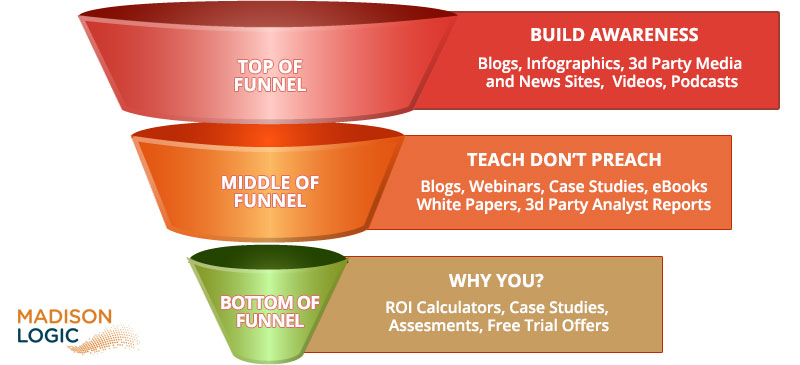
What Content Is Best for Each Stage of the Buyer’s Journey?

One of the most common questions we get at Madison Logic is what content is appropriate at each stage of the buyer journey. I’ve written about this before on the blog, but as more marketers begin to practice Journey Optimization™, it becomes increasingly important for B2B marketers to understand what content –and what messaging– works best at every stage.
Top of the Funnel: Build Awareness
At the top of the sales funnel is what is often referred to as your Total Addressable Market (TAM), it’s the largest number of potential customers out there. To understand who your TAM is, you should have identified your Ideal Customer Profile (ICP) and built a list of accounts that are your most likely customers.
But, like dating, just because you like someone doesn’t mean they’re going to like you back. This is where intent data comes in. At Madison Logic we help our clients prioritize their TAM.
Let’s say you have 5,000 accounts in your TAM. We’ll run those accounts through ActivateABM™ and identify those that are actively searching for products and solutions like yours. This is where you need to concentrate your efforts.
The goal at the Top of the Funnel is to educate your prospects. They’re likely looking to address a challenge or solve a problem. You need content that helps them understand how to meet and overcome those challenges. Again, an account-based marketing platform like ActivateABM™ comes into play here. Our clients not only understand that a specific account is conducting research, they understand the terms they are using to conduct that research.
With this insight in hand, Madison Logic clients create blogs, infographics, videos, and podcasts that are hyper-relevant, making their brand a trusted advisor for their most likely-to-buy accounts.

Middle of the Funnel: Teach Don’t Preach
In the graphic for this post, I’ve labeled the Middle of the Funnel “Teach Don’t Preach.” This means content that informs and doesn’t vigorously wave the flag of your brand.
The Middle of the Funnel is a tricky place to be. There is a broad diversity of leads here, each of them seeking for a solution to their own problem, each of them at a different stage of their unique journey. All of them have come this far with you, but they’re not ready to decide quite yet.
Now, if you have a marketing automation system in place, you should have a fairly good idea of where each prospect is in their journey. It allows a prospect to self-navigate, to progress through the buyer’s journey, consuming the content that best fits their needs.
You should avoid the mistake of concentrating on a single prospect at this stage. The person in your marketing automation isn’t always responsible for the ultimate decision. ActivateABM™, for example, tracks the activity of each account, allowing Madison Logic clients to deliver the appropriate content and messaging to the entire buying committee throughout the entire journey.
This stage requires the kind of educational content that continues to address their needs and challenges but begins to position your product as the ideal solution. Content such as blogs, webinars, white papers, case studies, and eBooks work best here.
Bottom of the Funnel: Why You?
At the Bottom of the Funnel, an account is nearly ready to make a final decision, it just needs to be persuaded that your product is the right solution. This is the “Why You?” stage. If leads have progressed this far, you should now be nurturing a relationship, not building one.
Case Studies still work here, but more effective are such things as ROI Calculators or Free Trial Offers. At this stage, it remains important to supplement the content with media that reinforces your Bottom of the Funnel message.
Your goal here is to initiate a dialogue and begin to fully qualify your most engaged accounts. At the bottom of the funnel, your prospect is more inclined to speak with a sales representative.
When that conversation happens, the rep should be armed with the insights gleaned from the prospect’s behavior through the funnel: What are they researching? With what contact have they interacted? Have the seen and interacted with your digital advertising? How many individuals from each account have you engaged? This information makes for more meaningful and effective conversations.
To learn more about how to deliver the best content and messaging
at every stage of the funnel, click here.

